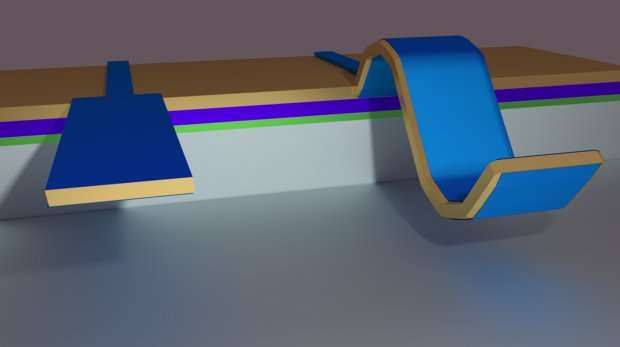Researchers develop flexo-electric nanomaterial

Researchers at the University of Twente's MESA+ research institute, together with researchers from several other knowledge institutions, have developed a 'flexo-electric' nanomaterial. The material has built-in mechanical tension that changes shape when you apply electrical voltage, or that generates electricity if you change its shape.
In an article published in the leading scientific journal Nature Nanotechnology, the researchers also show that the thinner you make the material, the stronger this flexo-electric effect becomes. Professor Guus Rijnders, who was involved in the research, describes this as a completely new field of knowledge with some interesting applications. You could use the material to recharge a pacemaker inside the human body, for example, or to make highly sensitive sensors.
Piezoelectric materials are widely used in electronic applications. In specific terms, these are crystalline materials that can convert electrical power into pressure and vice versa. The disadvantage of these materials is that they contain lead - which has environmental and health risks - and that the piezoelectric effect decreases when you make the material thinner.
The thinner the material, the stronger the effect
Ever since the 1960s physicists have been arguing that the flexo-electric effect could exist. This would enable non-piezoelectric materials to be given piezoelectric properties. At that time, however, manufacturing methods were inadequate for the production of such materials. Now, researchers from the University of Twente, the Catalan Institute of Nanoscience and Nanotechnology and Cornell University have succeeded in developing a flexo-electric nano system just 70 nanometres thick. It turns out that even though the flexo-electric effect is very weak, the thinner you make the material, the stronger the effect becomes.
Ultrasensitive sensors
According to Professor Guus Rijnders, who was involved in the research, it will eventually be possible to create flexo-electric materials with a thickness of just a few atomic layers. This discovery could have all kinds of interesting applications. 'You could make sensors that can detect a single molecule, for example. A molecule would land on a vibrating sensor, making it just fractionally heavier, slowing the vibration just slightly. The reduction in frequency could then easily be measured using the flexo-electric effect.' In addition to ultra-sensitive sensors, flexo-electric materials could also be useful in applications that require a limited amount of power, but which are difficult to reach, such as in pacemakers or cochlear implants inside the human body.
More information: Umesh Kumar Bhaskar et al. A flexoelectric microelectromechanical system on silicon, Nature Nanotechnology (2015). DOI: 10.1038/nnano.2015.260
Journal information: Nature Nanotechnology
Provided by University of Twente





















